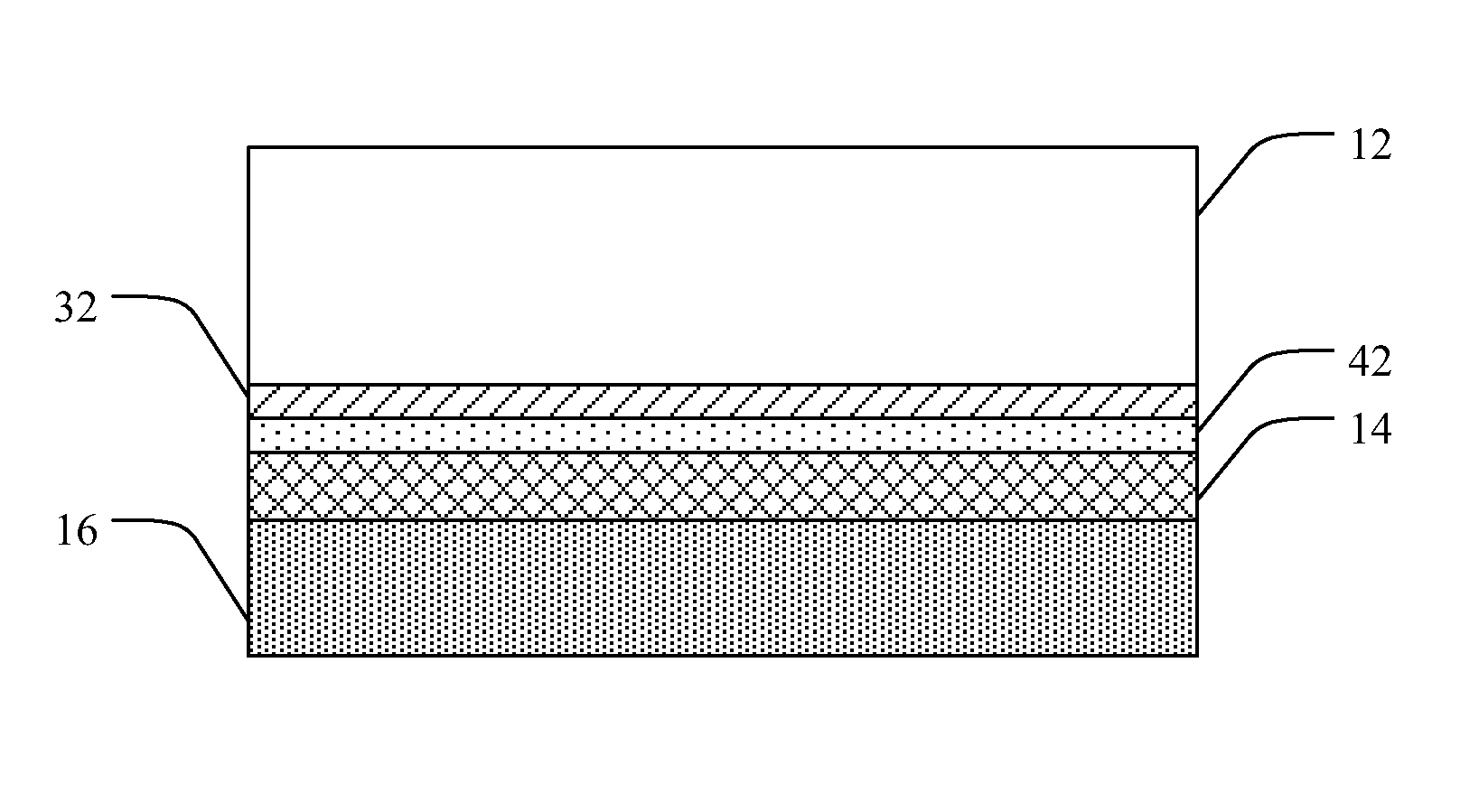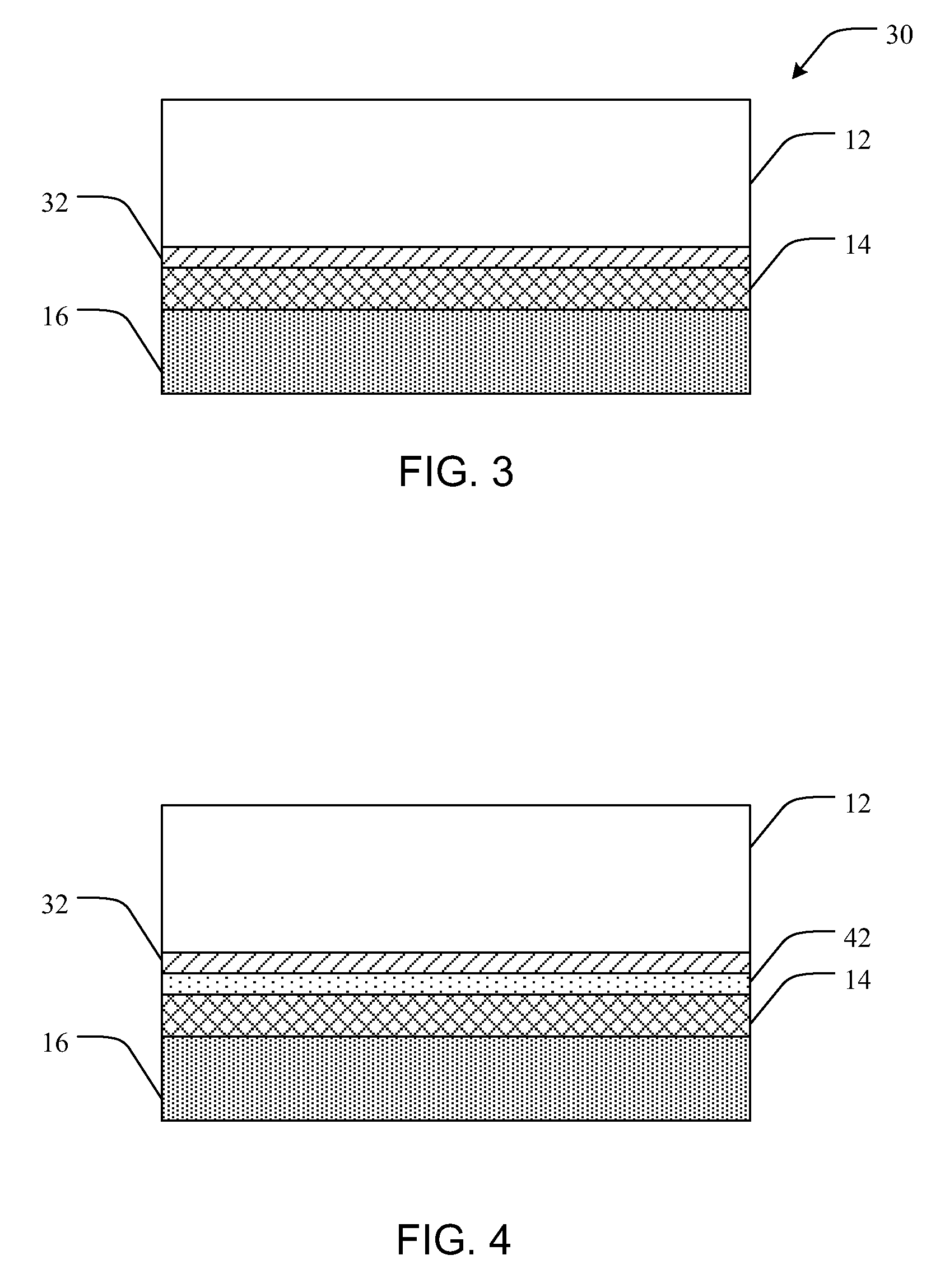Stress regulated semiconductor devices and associated methods
a technology of stress regulation and semiconductor devices, applied in semiconductor devices, semiconductor/solid-state device details, electrical apparatus, etc., can solve problems such as various thermal problems, increase in speed and decrease in size of electronic circuitry, and difficulty in cooling such devices
- Summary
- Abstract
- Description
- Claims
- Application Information
AI Technical Summary
Benefits of technology
Problems solved by technology
Method used
Image
Examples
example 1
[0075]A 2 inch sapphire wafer is deposited with epitaxial GaN by MOCVD (metal organic chemical vapor deposition). Trimethylgallium is used as the Ga source gas and ammonia is added to supply nitrogen atoms. Hydrogen is also added in order to dilute the gas and to gasify Ga or N atoms if they are located in unstable sites on the lattice. A multiple layered semiconductor structure is made by n-doping with Si on the sapphire followed by p-doping with Mg to form a junction. Quantum wells and intrinsic layers can be introduced between the p-doped layer and the n-doped layer. The top surface of the p-doped layer is sputtered with a reflective layer of Ag to a thickness of about 200 nm. The reflective layer is then sputtered with a nucleation enhancing layer of Ti to about 50 nm thick.
[0076]Subsequently, amorphous diamond is deposited on the nucleation enhancing layer to a thickness of about 1 μm by cathodic arc deposition. An additional nucleation enhancing layer of Ti is sputtered on the...
example 2
[0077]A 2 inch sapphire wafer is deposited with epitaxial GaN by MOCVD (metal organic chemical vapor deposition). Trimethylgallium is used as the Ga source gas and ammonia is added to supply nitrogen atoms. Hydrogen is also added in order to dilute the gas and to gasify Ga or N atoms if they are located in unstable sites on the lattice. A multiple layered semiconductor structure is made by n-doping with Si on the sapphire followed by p-doping with Mg to form a junction. Quantum wells and intrinsic layers can be introduced between the p-doped layer and the n-doped layer.
[0078]The top surface of the p-doped layer is cosputtered with graphite and Ag to form a reflective layer. The graphite acts to reduce the CTE of the reflective layer. In this case, the CTE can be graded by controlling Ag / C ratio. Ag coating is then resumed without graphite. The Ag layer is then thickened by electroplating with Cu or Ag.
example 3
[0079]A 2 inch sapphire wafer is deposited with epitaxial GaN by MOCVD (metal organic chemical vapor deposition). Trimethylgallium is used as the Ga source gas and ammonia is added to supply nitrogen atoms. Hydrogen is also added in order to dilute the gas and to gasify Ga or N atoms if they are located in unstable sites on the lattice. A multiple layered semiconductor structure is made by n-doping with Si on the sapphire followed by p-doping with Mg to form a junction. Quantum wells and intrinsic layers can be introduced between the p-doped layer and the n-doped layer.
[0080]The top surface of the p-doped layer is cosputtered with graphite and Ag to form a reflective layer. The graphite acts to reduce the CTE of the reflective layer. In this case, the CTE can be graded by controlling Ag / C ratio. Ag coating is then resumed without graphite. A monolayer of micron diamond particles is spread across the Ag layer, and a Cu layer is electroplated there upon to incorporate the diamond part...
PUM
| Property | Measurement | Unit |
|---|---|---|
| bond length | aaaaa | aaaaa |
| thick | aaaaa | aaaaa |
| thick | aaaaa | aaaaa |
Abstract
Description
Claims
Application Information
 Login to View More
Login to View More - R&D
- Intellectual Property
- Life Sciences
- Materials
- Tech Scout
- Unparalleled Data Quality
- Higher Quality Content
- 60% Fewer Hallucinations
Browse by: Latest US Patents, China's latest patents, Technical Efficacy Thesaurus, Application Domain, Technology Topic, Popular Technical Reports.
© 2025 PatSnap. All rights reserved.Legal|Privacy policy|Modern Slavery Act Transparency Statement|Sitemap|About US| Contact US: help@patsnap.com



